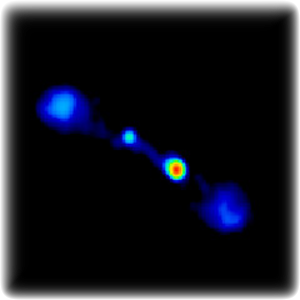 Approximately, every tenth galaxy is active. A question that naturally arises is whether activity or lack of it is a permanent feature of a given galaxy or transitions between active and inactive state are possible. In other words, can activity of a galaxy cease or can it be initiated in an inactive galaxy?
Approximately, every tenth galaxy is active. A question that naturally arises is whether activity or lack of it is a permanent feature of a given galaxy or transitions between active and inactive state are possible. In other words, can activity of a galaxy cease or can it be initiated in an inactive galaxy?
This question can now be answered owing to investigation of the morphologies of radio galaxies. It appears that their large-scale radio structures are highly durable. When the galactic nucleus becomes inactive the radio lobes are still observable, and they remain so for hundreds of millions of years. This way, it is possible to point out “post-active” galaxies, i.e. those that are currently inactive, but bearing signatures of former activity taking the form of relic lobes.
What’s most intriguing, however, is the recurrent activity which may be best demonstrated in formerly post-active galaxies. This is because when activity is restarted in a galaxy of this kind, a pair of new radio lobes emerges and the relic lobes that were generated during the previous active phase straddle them. Objects of this type are dubbed double-double radio sources.
Our group observes and interprets them. Recently, we have analyzed the history of activity of J1706+4340 radio galaxy. We have restored that history based on our observations of that object using VLA and GMRT. The galaxy’s relic lobes are 300 million years old, whereas the renewal of the activity took place only about 12 million years ago after about a 27 million-year-long period of quiescence.
Another object of this type we observed – this time with VLA, GMRT, and LOFAR – is J0028+0035 radio galaxy. A painstaking analysis of the observing data enabled us to unveil its history. It turned out that here the relic lobes are 245 million years old and the new active period began 3.6 million years ago after eleven-million-year long break. Interestingly, it is not obvious whether J0028+0035 is still active because the lobes created in the second active phase bear some properties typical for relics.
Group:
- dr hab. Andrzej Marecki, prof. UMK
- dr hab Krzysztof Katarzyński, prof. UMK (www)
- dr Marcin Gawroński
Important publications:
- Katarzyński K., Sol H., Kus A. (2001) The multifrequency emission of Mrk 501. From radio to TeV gamma-rays, A&A 367, 809
- Gawroński M. P., Marecki A., Kunert-Bajraszewska M., Kus A. (2006) Hybrid morphology radio sources from the FIRST survey, A&A 447, 63
- Katarzyński K., Ghisellini G., Tavecchio F., Gracia J., Maraschi L. (2006) Hard TeV spectra of blazars and the constraints to the infrared intergalactic background, MNRAS 368, L52
- Marecki A., Szablewski M. (2009) Evidence of a double-double morphology in B0818+214, A&A 506, L33
- Marecki A., Swoboda B. (2011) The transition from quasar radio-loud to radio-quiet state in the framework of the black hole scalability hypothesis, A&A 525, 6
- Marecki A., Swoboda B. (2011) More evidence for extinction of activity in galaxies, A&A 530, 60
- Marecki A. (2012) Activity restart – a key to explaining the morphology of J1211+743, A&A 544, L2
- Marecki A. (2012) Are 3C 249.1 and 3C 334 restarted quasars?, A&A 545, 132
- Cegłowski M., Gawroński M. P., Kunert-Bajraszewska M. (2013) Orientation of the cores of hybrid morphology radio sources, A&A 557, 75
- Marecki A., Sokołowska A. (2014) Multi-epoch VLBA observations of radio galaxy 0932+075: is this a compact symmetric object?, A&A 569, 22
- Marecki A., Jamrozy M., Machalski J. (2016) Multifrequency study of a double–double radio galaxy J1706+4340, MNRAS 463, 338
- Marecki A., Jamrozy M., Machalski J., Pajdosz-Śmierciak U. (2021) Multifrequency study of a double–double radio galaxy J0028+0035, MNRAS 501, 853

 Piwnice k. Torunia, 87-148 Łysomice
Piwnice k. Torunia, 87-148 Łysomice